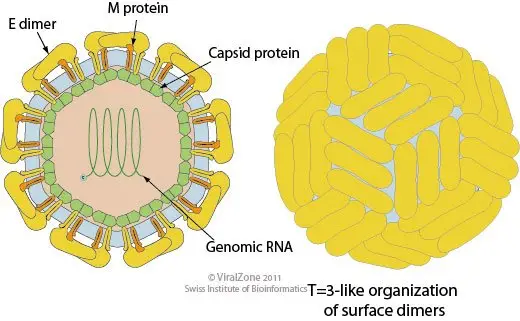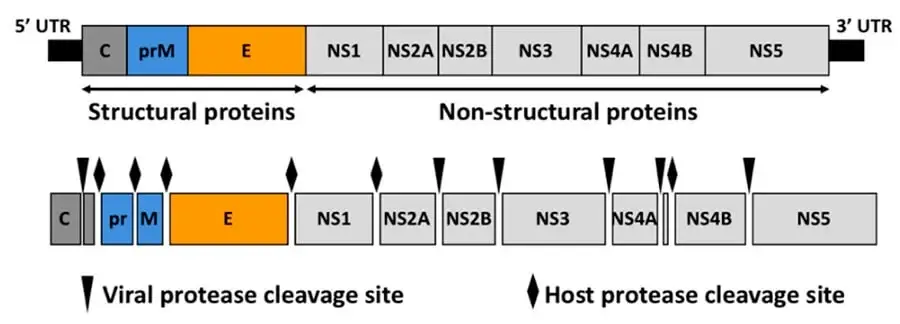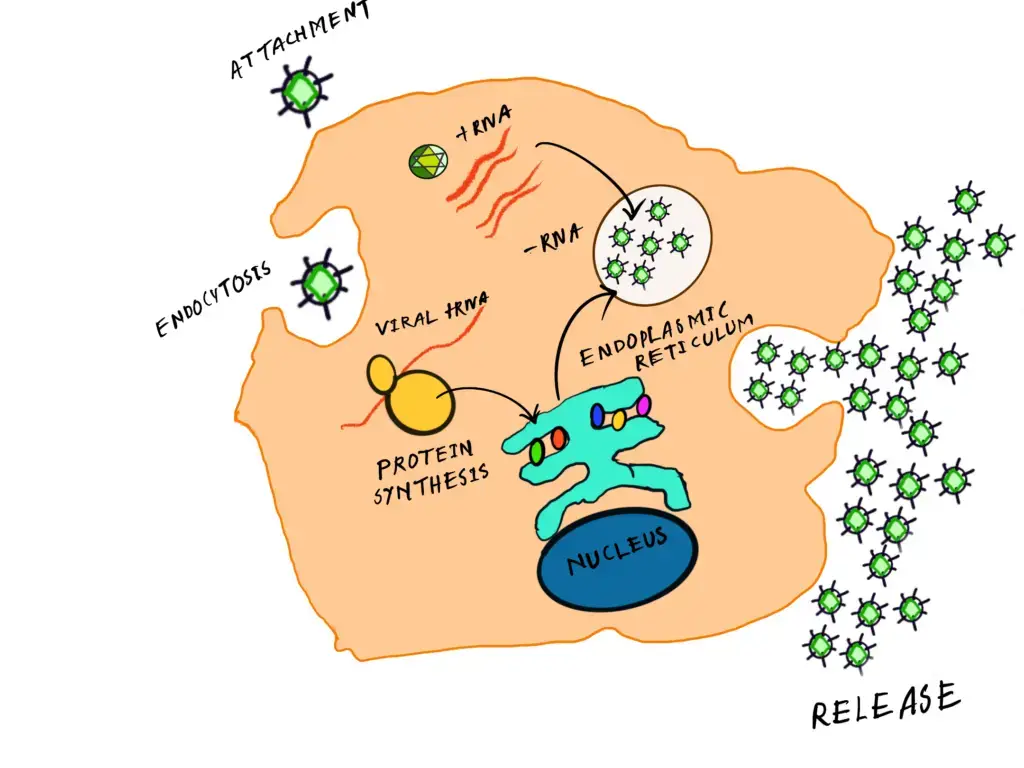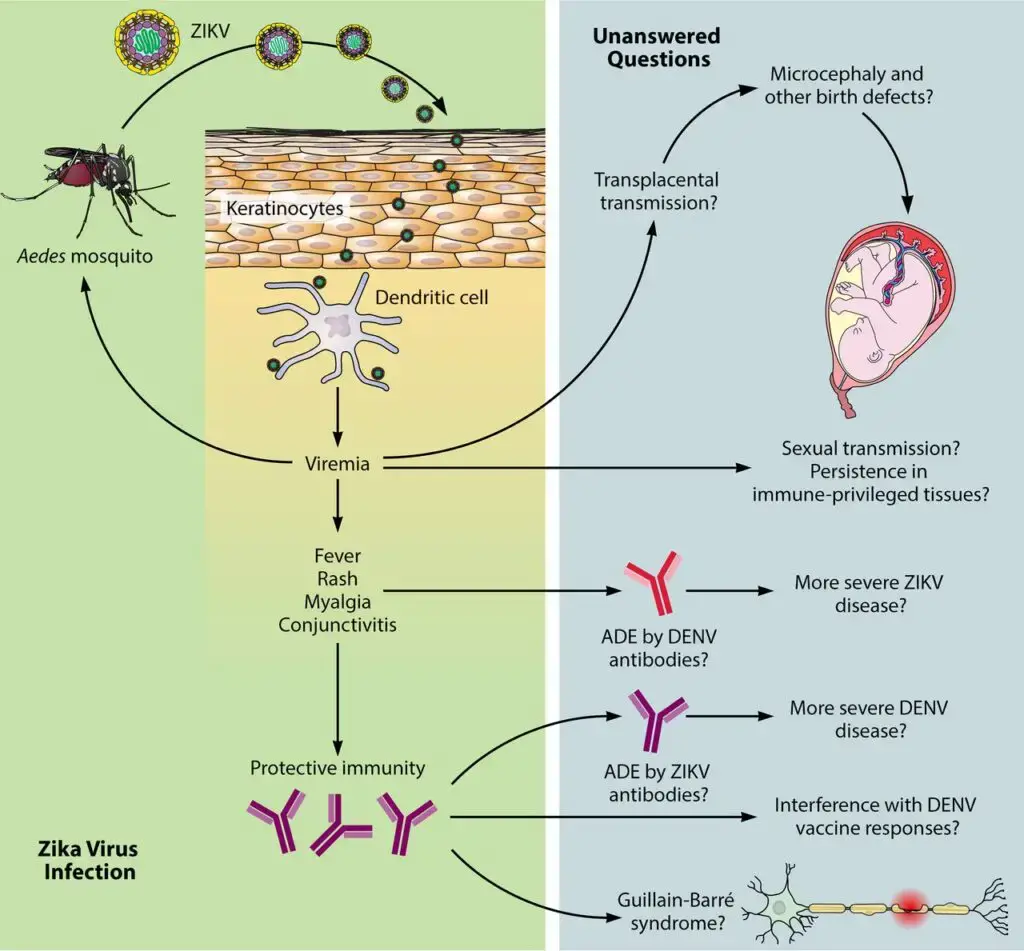Zika Virus (ZIKV)
- Zika virus is a member of the Flaviviridae virus family. It is transmitted by daytime-active Aedes mosquitoes, including Aedes aegypti and Aedes albopictus. It was first isolated in 1947 in the Ziika Forest of Uganda, from which it derives its name.
- Dengue, yellow fever, Japanese encephalitis, and West Nile viruses all belong to the same genus as Zika virus. Since the 1950s, it has been recognized that the disease occurs within a limited equatorial belt stretching from Africa to Asia. From 2007 to 2016, the virus spread east across the Pacific Ocean to the Americas, resulting in the Zika virus epidemic of 2015–2016.
- The infection, also known as Zika fever or Zika virus disease, typically causes no or moderate symptoms, similar to a mild form of dengue fever. While no specific treatment exists, paracetamol (acetaminophen) and rest may alleviate the symptoms.
- As of April 2019, no vaccines have been authorized for clinical use, but a number of vaccines are undergoing clinical trials.
- Zika can transmit from an expectant woman to her unborn child. This may cause microcephaly, severe brain malformations, and additional birth defects. Infrequently, Zika infections in adults may cause Guillain-Barré syndrome.
Characteristics of Zika Virus (ZIKV)
- Zika virus is a member of the Flaviviridae family and the Flavivirus genus, and is therefore related to the dengue, yellow fever, Japanese encephalitis, and West Nile viruses.
- Zika virus, like other flaviviruses, is enveloped and icosahedral and possesses a 10 kilobase, nonsegmented, single-stranded, positive-sense RNA genome. It is one of the two known viruses in the Spondweni virus clade and is most closely related to the Spondweni virus.
- An RNA genome with a positive sense can be directly translated into viral proteins. Similar to other flaviviruses, including the similarly sized West Nile virus, the RNA genome encodes seven nonstructural proteins and three structural proteins as a single polyprotein (Q32ZE1).
- Among the structural proteins, the virus is encapsulated. This protein is the flavivirus envelope glycoprotein, which initiates endocytosis by binding to the endosomal membrane of the host cell. The RNA genome, along with copies of the 12-kDa capsid protein, forms a nucleocapsid.
- The nucleocapsid is encased in a membrane derived from the host and modified with two viral glycoproteins. Viral genome replication is dependent on the synthesis of double-stranded RNA from the single-stranded, positive-sense RNA (ssRNA(+)) genome, followed by transcription and replication to generate viral messenger RNAs (mRNAs) and new ssRNA(+) genomes.
- A longitudinal study reveals that six hours after Zika virus infection, the vacuoles and mitochondria of infected cells begin to expand. This enlargement becomes so severe that it causes cell death, also known as paraptosis. This type of programmed cell suicide is dependent on gene expression.
- IFITM3 is a transmembrane protein within a cell that can prevent viral infection by inhibiting virus attachment. Cells are most vulnerable to Zika infection when IFITM3 levels are low. Once a cell has been infected, the virus restructures the endoplasmic reticulum, resulting in the formation of large vacuoles and demise of the cell.
- Two Zika lineages exist: the African lineage and the Asiatic lineage. The virus spreading in the Americas is 89% identical to African genotypes, but is most closely related to the Asian strain that circulated in French Polynesia during the 2013–2014 pandemic, according to phylogenetic studies.
Structure of Zika Virus

- The Zika virus has a round shape, similar to a golf ball, with a smooth outer layer. The major protein on this layer, called E protein, is parallel to the virus membrane. The virus is very small, measuring only 50 nanometers. Its membrane contains 180 copies of E and M proteins.
- The virus has a genetic material called RNA, which has three structural proteins and is covered by a lipid envelope. The E protein has four parts, including a stem, a transmembrane section, and three other parts called ectodomains.
- The E protein is mainly found on the outer surface of the virus, and about half of its protein sequence is the same in both Zika and dengue virus strains. The M protein is smaller than the E protein and is located below it. The E and M proteins are arranged in a special way on the virus membrane.
- The virus also has a protein called prM, which is connected to the virus membrane. In immature Zika viruses, the prM and E proteins form spikes on the surface that are arranged in a symmetrical pattern. These immature viruses then go through a process where the prM protein is cleaved by a host enzyme.
- The mature Zika virus has a smooth outer surface, made up of 90 E protein pairs arranged parallel to the virus membrane.
Genome Structure of Zika Virus

- The Zika virus (ZIKV) is made up of a single strand of genetic material called RNA. This RNA is about 10,700 bases long and contains a single set of instructions for making proteins.
- The RNA has two regions at its ends that do not code for proteins, called untranslated regions (UTRs). These regions help the virus to replicate and make copies of itself.
- The genetic instructions in the RNA are used to make a large protein called a polyprotein. This polyprotein is then broken down into smaller proteins, including three structural proteins called capsid (C), pre-membrane (prM), and envelope (E), as well as seven non-structural proteins called NS1, NS2A, NS2B, NS3, NS4A, NS4B, and NS5.
- The structural proteins make up the physical structure of the virus, while the non-structural proteins help to replicate the virus’s genetic material, process the polyprotein, and control the virus’s interaction with the host.
Zika Virus Replication
Viruses cannot replicate until they infect and “reprogram” appropriate host cells to become virus-producing factories. The epidermis and dermis of the host skin contain fibroblast, keratinocytes, and immature dendritic cells where the Zika virus replicates. In mammals, multiplications occur in the cytoplasm, while in insects they may occur in the nucleus. Zika virus replication involves:

- Attachment of the viral envelope protein E to host receptors, followed by endocytic internalization of the virion into the host cell. The discharge of RNA genome into the cytoplasm.
- The positive-sense genomic ssRNA is translated into a polyprotein that is then cleaved into all structural and nonstructural proteins of the virus. Replication occurs at the endoplasmic reticulum surface in cytoplasmic viral factories.
- The genomic ssRNA (+) is used to synthesize a dsRNA genome. The dsRNA genome is replicated and transcribed, producing viral mRNAs and new ssRNA (+) genomes.
- At the endoplasmic reticulum and Golgi apparatus, virus particles assemble and are processed. In the Golgi, the prM protein is cleaved, maturing the virion and rendering it infectious. New virions are released by exocytosis, resulting in viremia and body fluid dissemination.
Pathogenesis of Zika Virus

- Mosquito-borne flaviviruses replicate initially in dendritic cells near the site of the infectious bite, then spread quickly to lymph nodes, where they replicate and reach the bloodstream.
- In vitro, ZIKV infects fibroblasts and keratinocytes, but the pathogenesis of ZIKV in vivo remains largely unknown, including its distribution in anatomic tissues and the immune response to primary ZIKV in humans and other animals.
- Several species of immunocompromised mice and NHPs, such as rhesus, pigtail, and cynomolgus monkeys, were used for studies of the natural behavior and pathogenesis of ZIKV infection, as well as to evaluate NHPs as ZIKV study models.
- All assays of rhesus and cynomolgus monkeys have shown to be permissive for infection by the Asian strain of ZIKV. Virus RNA was detected in several body fluids, such as plasma, urine, saliva, cerebrospinal fluid, semen, seminal fluids, and vaginal fluids, 1–10 days postinfection (DPI).
- Cynomolgus monkeys presented higher viral loads of ZIKV in testis 8 DPI, and after 2–3 weeks of infection, neutralizing antibodies to ZIKV were detected in most animals.
- Cynomolgus monkeys were challenged with the African lineage, but they were not permissive. Rhesus monkeys that were reinfected did not observe viral replication, which could mean that the monkeys may acquire immune protection after the first ZIKV exposure.
- Viremia and viruria were detected in two of the four total animals by RT-qPCR, and peak plasma viremia occurred between 5–10 DPI as extrapolated from qPCR.
- Viruria was detected at 9 and 14 dpi, and salivary ZIKV secretion was detected in three animals as late as 14 dpi. Two of the four owl monkeys had ZIKV viremia at 2 and 4 dpi by PCR, but ZIKV was not detected in urine, salivary secretions, or excretions from owl monkeys by culture or qPCR assays.
Epidemiology of Zika Virus
- It has been associated with sporadic human infections in Africa and Asia since its isolation from Uganda.
- The most extraordinary details are available from the epidemics that occurred in Yap Island, Micronesia (2007), French Polynesia (2013), and New Caledonia (2015). (2014).
- Infection with ZIKV was confirmed in Brazil in May 2015, and by January 2016, the epidemic had spread to numerous nations in the Americas, including Bolivia, Brazil, Cape Verde, Colombia, Dominican Republic, Ecuador, El Salvador, French Guiana, Guadeloupe, Guatemala, Guyana, Haiti, Honduras, Martinique, Mexico, Panama, Paraguay, Saint Martin, Samoa, Suriname, and Venezuela.
Transmission of Zika Virus
- Transmission of ZIKV to humans occurs primarily through the bite of an infected Aedes aegypti mosquito, which breeds in fresh stagnant water and typically bites during the day (both indoors and outdoors).
- Aedes albopictus and additional Aedes mosquito species (A. africanus, A. luteocephalus, A. furcifer, and A. taylori) are also capable of transmitting the virus.
- Few cases of presumptive sexual transmission of ZIKV have been reported in women who had sexual relations with companions who were afflicted with ZIKV.
- Researchers have also validated the presence of ZIKV RNA in the affected male’s sperm, supporting the theory of sexual transmission of the ZIKV virus.
- Blood, urine, saliva, cerebrospinal fluid (CSF), amniotic fluid, and breast milk have all been found to contain ZIKV RNA.
- As the virus can cross the placental barrier and cause congenital (intrauterine) infection, maternal to fetal transmission and intrapartum transmission are both possible.
- Transmission of ZIKV through breastfeeding has not yet been described; therefore, it is advised that affected mothers continue breastfeeding their infants.
Clinical Manifestations of Zika Virus
Symptoms of Zika virus (ZIKV) infection are present in only around 20% of cases, with the majority of patients being asymptomatic.
Common symptoms include:
- Low-grade fever with maculopapular rash
- Arthralgia (involving the small joints of hands and feet)
- Non-purulent conjunctivitis
- Headache
- Retro-orbital pain
- Myalgia
- Asthenia
- Peripheral edema
- Gastrointestinal disturbance (abdominal pain, nausea, diarrhea)
These symptoms usually occur 2-12 days after being bitten by an Aedes mosquito, and typically last for 2-7 days. Patients with symptoms and a history of travel to ZIKV endemic areas should be suspected of having ZIKV.
Infants and children with postnatal ZIKV infection experience similar symptoms as adults. Arthralgia in infants and young children may present as irritability, difficulty moving or refusing to move an extremity, or pain with active or passive movement of the affected joint or on palpation of the joint.
- ZIKV infection is associated with various complications including congenital microcephaly, Guillain-Barré syndrome, and fetal loss in women infected during pregnancy.
- Congenital (intrauterine) infection: ZIKV infection in pregnant mothers can cause microcephaly in infants, especially if acquired during the first trimester, and has been associated with cases of muscular atrophy in children born during the ZIKV outbreak in Brazil.
- ZIKV infection during pregnancy can also result in poor fetal outcomes such as central nervous system injury, placental insufficiency, fetal growth restriction, and fetal death.
- Neurological complications: ZIKV infection has been associated with Guillain-Barré syndrome, with about 90% of patients having reported ZIKV symptoms prior to neurological symptoms. Other neurological manifestations include acute myelitis and meningoencephalitis.
- Other reported symptoms from ZIKV infection in travelers include ankle edema, lymphadenopathy, leukopenia with monocytosis, and thrombocytopenia.
Diagnosis of Zika Virus
- Serum reverse transcription polymerase chain reaction (RT-PCR) for detection of Zika virus RNA in the acute phase of viremia (first 3-7 days of illness onset).
- Detection of Zika virus-specific IgM antibodies in serum by serology. However, this method has limitations due to cross-reactivity with other flaviviruses like dengue virus and chikungunya virus.
- Detection of Zika virus RNA in urine and saliva using RT-PCR. This method may have a longer detection window compared to serum.
- Prenatal fetal evaluation of pregnant women suspected or confirmed to have Zika virus infection or exposure by regular fetal ultrasound examination. Abnormalities include microcephaly, intracranial calcifications, hydranencephaly, ventricular dilatation, brain atrophy, anhydramnios, hydrops fetalis, and intrauterine growth retardation.
Treatment of Zika Virus
- There is currently no specific treatment available for Zika virus infection. Treatment mainly involves symptomatic relief and supportive care.
- For fever and pain relief, acetaminophen (paracetamol) is recommended instead of aspirin or nonsteroidal anti-inflammatory drugs (NSAIDs), which may increase the risk of bleeding in dengue virus co-infections.
- Patients with Zika virus infection should also be advised to drink plenty of fluids to prevent dehydration. Rest is also important to help the body fight the infection.
- For pregnant women, close monitoring of the pregnancy is necessary to detect any fetal abnormalities that may be associated with Zika virus infection.
- If a pregnant woman has been diagnosed with Zika virus infection, further testing and specialized care may be required, depending on the severity of the fetal abnormalities detected.
- Prevention of Zika virus infection through measures such as avoiding mosquito bites, wearing protective clothing, and using mosquito repellent is also an important aspect of treatment.
Prevention and Control of Zika Virus
Prevention and control of Zika virus primarily involves measures to control the growth and elimination of the Aedes mosquito vector and prevent mosquito bites, as well as avoiding sexual transmission.
Some prevention and control measures include:
- Control of mosquito breeding: Since Aedes mosquitoes breed in stagnant water, it’s important to identify and eliminate potential breeding sites of water stagnation. This involves proper disposal of waste, covering water containers, clearing blocked drains, and keeping the surrounding areas clean.
- Preventing mosquito bites: This can be done by wearing long sleeve shirts and pants, using insect repellent, and staying indoors as much as possible, especially during peak mosquito activity times. Air conditioning, window and door screens, and mosquito nets can also be used to prevent mosquito bites.
- Barrier methods during sexual intercourse: The use of condoms or abstinence from sexual intercourse can help prevent sexual transmission of Zika virus.
- Travel precautions: Travelers should be aware of the risk of Zika virus transmission in areas where the Aedes mosquito is prevalent and take necessary precautions to avoid mosquito bites.
It’s important for all stakeholders, including clinicians, healthcare workers, the general public, government agencies, and NGOs, to play a role in disseminating information and implementing measures to prevent and control the spread of Zika virus.
Key facts
- The Zika virus is transmitted predominantly by daytime-biting Aedes mosquitoes.
- The majority of individuals infected with the Zika virus do not develop symptoms; those who do typically experience rash, fever, conjunctivitis, muscle and joint pain, malaise, and headache for 2–7 days.
- Infection with the Zika virus during pregnancy can result in microcephaly and other congenital anomalies, as well as preterm birth and miscarriage.
- Infection with the Zika virus is linked to Guillain-Barré syndrome, neuropathy, and myelitis in both adults and infants.
- In February 2016, the World Health Organization (WHO) proclaimed microcephaly related to Zika a Public Health Emergency of International Concern (PHEIC), and the causal link between the Zika virus and birth defects was confirmed. In November of that same year, WHO declared the end of the PHEIC.
- Although Zika virus disease cases have decreased globally since 2017, transmission persists at low levels in a number of countries in the Americas and other endemic regions.
FAQ
What is the Zika virus (ZIKV)?
ZIKV is a mosquito-borne virus that was first identified in the Zika Forest of Uganda in 1947. It is a flavivirus that is closely related to dengue, yellow fever, and West Nile viruses.
How is the Zika virus transmitted?
ZIKV is primarily transmitted to humans through the bites of infected Aedes mosquitoes, which are also responsible for transmitting dengue and chikungunya viruses. It can also be transmitted through sexual contact, blood transfusions, and from mother to child during pregnancy or breastfeeding.
What are the symptoms of Zika virus infection?
Many people infected with ZIKV do not develop symptoms or only have mild symptoms, including fever, rash, headache, joint and muscle pain, and red eyes. However, ZIKV infection during pregnancy can cause serious birth defects and neurological complications in infants.
Is there a vaccine for the Zika virus?
Currently, there is no vaccine for ZIKV, but several vaccines are in development and undergoing clinical trials. Prevention measures include using insect repellents, wearing protective clothing, and eliminating standing water to reduce mosquito breeding sites.
Can the Zika virus be treated?
There is no specific treatment for ZIKV infection, and most people recover without complications. Treatment involves managing symptoms, such as fever and pain, and ensuring adequate hydration. People with severe symptoms or complications may need hospitalization.
Can the Zika virus be sexually transmitted?
Yes, the Zika virus can be sexually transmitted from an infected partner, even if they do not have symptoms. It can also be transmitted through blood transfusions and from mother to child during pregnancy, childbirth, or breastfeeding.
Who is at risk for Zika virus infection?
Anyone who lives in or travels to areas with active mosquito-borne transmission of ZIKV is at risk for infection. Pregnant women, especially in their first and second trimesters, are at increased risk of complications and should take extra precautions to prevent mosquito bites.
Can the Zika virus cause birth defects?
Yes, ZIKV infection during pregnancy can cause a range of birth defects collectively known as congenital Zika syndrome, including microcephaly, brain abnormalities, eye defects, hearing loss, and joint and muscle problems.
How can pregnant women protect themselves from Zika virus infection?
Pregnant women should avoid traveling to areas with active ZIKV transmission. If travel is unavoidable, they should take precautions to prevent mosquito bites, such as using insect repellent, wearing long sleeves and pants, and staying in air-conditioned or screened-in areas. They should also use condoms or abstain from sex with a partner who has traveled to an area with ZIKV transmission.
What should I do if I think I have been infected with the Zika virus?
If you develop symptoms of ZIKV infection, especially if you have traveled to an area with active transmission or had sex with a partner who has traveled to an area with ZIKV transmission, you should seek medical attention. Your healthcare provider can order tests to confirm the diagnosis and provide appropriate care and management.
References
- Rawal G, Yadav S, Kumar R. Zika virus: An overview. J Family Med Prim Care. 2016 Jul-Sep;5(3):523-527. doi: 10.4103/2249-4863.197256. PMID: 28217576; PMCID: PMC5290753.
- German Advisory Committee Blood (Arbeitskreis Blut), Subgroup ‘Assessment of Pathogens Transmissible by Blood’. Zika Virus (ZIKV). Transfus Med Hemother. 2016 Nov;43(6):436-446. doi: 10.1159/000447782. Epub 2016 Oct 14. PMID: 27994533; PMCID: PMC5159718.
- Quanquin, N., Adachi, K., & Nielsen-Saines, K. (2020). Zika virus. Maternal Immunization, 289–319. doi:10.1016/b978-0-12-814582-1.00014-0
- Okafor, Innocent. (2016). zika-virus-the-emerging-global-health-challenge. Diversity and Equality in Health and Care. 13. 394-401. 10.21767/2049-5471.100083.
- Catenacci, L. S., & De Alcantara, B. N. (2019). Zika Virus. Fowler’s Zoo and Wild Animal Medicine Current Therapy, Volume 9, 280–286. doi:10.1016/b978-0-323-55228-8.00041-2
- https://www.unicef.org/innovation/zika-virus-zikv-vaccine
- https://www.who.int/news-room/fact-sheets/detail/zika-virus
- https://www.cdc.gov/zika/index.html
- Text Highlighting: Select any text in the post content to highlight it
- Text Annotation: Select text and add comments with annotations
- Comment Management: Edit or delete your own comments
- Highlight Management: Remove your own highlights
How to use: Simply select any text in the post content above, and you'll see annotation options. Login here or create an account to get started.